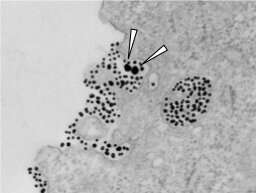A novel cellular process to engulf nano-sized materials

Nanometers are one billionth of a meter, a metric typically used to measure molecules and scientific building blocks not visible to the human eye. Materials of tens and/or several hundred nanometers in diameter have unique properties, and thus have been widely used in diagnosing and treating various human diseases. One major challenge to use these nano-sized materials is how to deliver them into cells and reach their sites of action.
Traditional methods include linking them to short fragments of proteins called peptides, which are structural components of cells and tissues, hormones, toxins, antibiotics and enzymes. These peptides, by interacting with cells, will lead nanomaterial into cells. The impact of these interactions on other cellular activities remains poorly understood, plus this peptide coupling introduces additional complexity in nanomaterial manufacturing, and may change their functionality as well.
In a study published in Nature Communications, University of Minnesota researchers discovered a novel cellular process that can engulf nanomaterial without direct peptide functionalization, and its activity is regulated by Cysteine surrounding the cells. The research team termed this cellular process of engulfing bystander NPs as 'bystander uptake.'
"By simply mixing two types of nano-sized material, we discover a novel cellular process that offers an easy solution for nanomaterial entry into cells," said Hongbo Pang, corresponding author, an assistant professor in the College of Pharmacy and a member of the Masonic Cancer Center. "Moreover, it opens up a new avenue of cell biology that interconnects several fundamental elements of living cells. Further understanding of this process will aid in both cell biology and nanotechnology development."
The study revealed the following unique properties:
- the bystander uptake only allows the cells to engulf nano-sized materials, but not other substances surrounding the cells (e.g. fluids);
- the activity of this bystander uptake is stimulated by the existence of one of 20 natural amino acids, Cysteine, surrounding the cells.
These phenomena have been validated with a wide variety of cells, nanoparticles (aka nanomaterials), and under various physiological conditions.
The study findings included:
- co-administration with TAT-NP, a peptide and nanomaterial fusion, enables cells to engulf nano-sized materials in a bystander manner;
- this bystander uptake is specific to nanomaterial, but not other substances surrounding the cells;
- cysteine in the cell culture medium greatly stimulates the activity of this bystander uptake.
More information: Yushuang Wei et al, Cellular internalization of bystander nanomaterial induced by TAT-nanoparticles and regulated by extracellular cysteine, Nature Communications (2019). DOI: 10.1038/s41467-019-11631-w
Journal information: Nature Communications
Provided by University of Minnesota



















